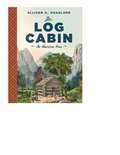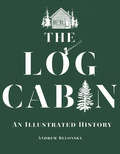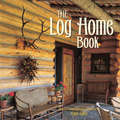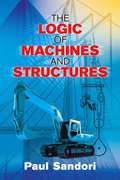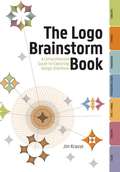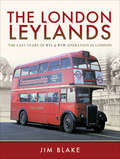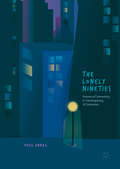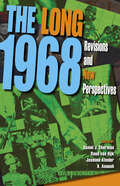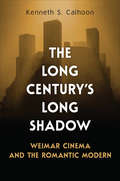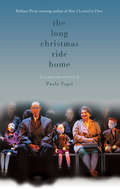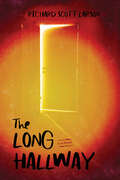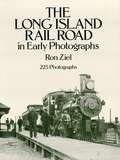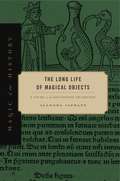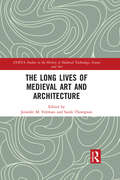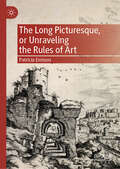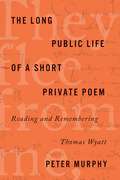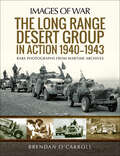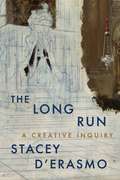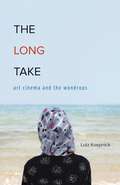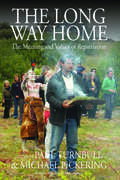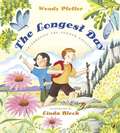- Table View
- List View
The Log Cabin: An American Icon
by Alison K. HoaglandFor roughly a century, the log cabin occupied a central and indispensable role in the rapidly growing United States. Although it largely disappeared as a living space, it lived on as a symbol of the settling of the nation. In her thought-provoking and generously illustrated new book, Alison Hoagland looks at this once-common dwelling as a practical shelter solution--easy to construct, built on the frontier’s abundance of trees, and not necessarily meant to be permanent--and its evolving place in the public memory. Hoagland shows how the log cabin was a uniquely adaptable symbol, responsive to the needs of the cultural moment. It served as the noble birthplace of presidents, but it was also seen as the basest form of housing, accommodating the lowly poor. It functioned as a paragon of domesticity, but it was also a basic element in the life of striving and wandering. Held up as a triumph of westward expansion, it was also perceived as a building type to be discarded in favor of more civilized forms. In the twentieth century, the log cabin became ingrained in popular culture, serving as second homes and motels, as well as restaurants and shops striking a rustic note. The romantic view of the past, combined with the log cabin’s simplicity, solidity, and compatibility with nature, has made it an enduring architectural and cultural icon.Preparation of this volume has been supported by Furthermore: a program of the J. M. Kaplan Fund
The Log Cabin: An Illustrated History
by Andrew BelonskyExplore the history and lore behind a uniquely American icon Like a wooden security blanket that Americans reach for when times get tough, the log cabin has endured as a uniquely American symbol of home and hearth. This strain of cabin fever is no fleeting trend: It has struck at regular intervals since the early 1900s, when log cabin vacations first became an option for an increasingly mobile America. Now the cozy cabin aesthetic is found, like a collective fantasy, in every corner of our national culture. But how did it all begin? This is an image-driven history of log cabins in America. Exploring the log cabin’s hidden past, this book draws on colonial diaries and journalistic accounts, as well as paintings, illustrations, and graphics to show how the log cabin—once derided as a poor immigrant’s hovel—became an American institution and a modern ambition. Bursting with quirk, charm, and fascinating trivia, The Log Cabin is the perfect companion for cabin dwellers, vacationers, and daydreamers alike.
The Log Home Book
by Ralph KylloeRoom-by-room inspiration for the affordable mountain retreat of your dreams, from the author of Rustic Elegance and Ralph Kylloe&’s Rustic Living. A foremost authority on rustic design and furnishings, Ralph Kylloe chose for this book his most inspiring images from twenty years of photographing mountain retreats across America. Richly layered images of living rooms, kitchens, dining rooms, bedrooms, bathrooms, and recreation rooms are a springboard for cabin planning and vacation dreaming.
The Logic of Machines and Structures
by Paul SandoriBased on common, everyday phenomena, the principles governing the balance of forces on machines and structures are extremely straightforward. Their expression in mathematical form, however, obscures their clarity. This volume exposes the principles of statics in their original simplicity, presenting them as an exercise in logic. The modern analytical method of reasoning is carefully preserved to assist students in their grasp of the thinking that underlies mathematical methods of analysis.Suitable for architecture and engineering students as well as other readers with minimal background in mathematics, this unique treatment also restores enjoyment to the study of statics. Author Paul Sandori develops the subject using crucial highlights and discoveries in the field's historical evolution, noting the brilliant early insights and intuitions that contributed to the modern science. The text is complemented by illustrations of source materials from Galileo, Newton, and others that document the discipline's evolution.
The Logo Brainstorm Book
by Jim KrauseDon't Wait for Inspiration to Strike Whether you're facing a new logo project or you've reached a block in your current work,The Logo Brainstorm Bookwill inspire you to consider fresh creative approaches that will spark appealing, functional and enduring design solutions. Award-winning designer Jim Krause (author of the popularIndexseries) offers a smart, systemic exploration of different kinds of logos and logo elements, including: Symbols Monograms Typographic Logos Type and Symbol Combinations Emblems Color Palettes Through a combination of original, visual idea-starters and boundary-pushing exercises,The Logo Brainstorm Bookwill help you develop raw logo concepts into presentation-ready material.
The Logo Brainstorm Book
by Jim KrauseDon't Wait for Inspiration to Strike Whether you're facing a new logo project or you've reached a block in your current work, The Logo Brainstorm Book will inspire you to consider fresh creative approaches that will spark appealing, functional and enduring design solutions. Award-winning designer Jim Krause (author of the popular Index series) offers a smart, systemic exploration of different kinds of logos and logo elements, including: Symbols Monograms Typographic Logos Type and Symbol Combinations Emblems Color Palettes Through a combination of original, visual idea-starters and boundary-pushing exercises, The Logo Brainstorm Book will help you develop raw logo concepts into presentation-ready material.
The Logo Brainstorm Book: A Comprehensive Guide for Exploring Design Directions
by Jim KrauseDon't Wait for Inspiration to StrikeWhether you're facing a new logo project or you've reached a block in your current work, The Logo Brainstorm Book will inspire you to consider fresh creative approaches that will spark appealing, functional and enduring design solutions.Award-winning designer Jim Krause (author of the popular Index series) offers a smart, systemic exploration of different kinds of logos and logo elements, including:SymbolsMonogramsTypographic LogosType and Symbol CombinationsEmblemsColor Palettes Through a combination of original, visual idea-starters and boundary-pushing exercises, The Logo Brainstorm Book will help you develop raw logo concepts into presentation-ready material.
The London Leylands: The Last Years of RTL and RTW Operation in London
by Jim BlakeLONDON'S FAMOUS RT-TYPE BUSES were an iconic symbol of our Capital city in the 1950s, before being superseded by the Routemasters. Most were built between 1947 and 1954 to replace worn-out pre-war and wartime buses, as well as our remaining trams. More than 7,000 were built in all and although London Transport favored A.E.C. chassis, which the first batches of RTs had, so pressing was the need for new buses that not enough could be supplied by that manufacturer to match demand. Therefore Leyland Motors were contracted to adapt their Leyland "Titan" PD2 chassis to fit bodies that, for the most part, were identical with those on RTs. The result was the 1,631-strong RTL class, together with the 500 RTWs, which had bodies also built by Leyland to the same general design, were built between 1948 and 1954. Always in a minority compared to the 4,825-strong RT class, these Leyland buses had a character all of their own, perhaps personified by their louder engine note. They also had a reputation for being heavier on their steering than the RTs, making them unpopular with staff, and therefore general withdrawal of them commenced in 1958, taking almost ten years to complete (in November 1968), whereas the RTs soldiered on until April 1979. During the RTL and RTW class buses' final years, Jim Blake was out and about photographing them throughout London. A selection of his photographs of them, most previously unpublished, is presented here. Nearly fifty years after their demise from London's streets, the RTLs and RTWs still have a firm following amongst bus enthusiasts and preservationists alike, and it is to them that this book is dedicated!
The Lonely Nineties: Visions of Community in Contemporary US Television
by Paul ArrasThis book examines the most popular American television shows of the nineties—a decade at the last gasp of network television’s cultural dominance. At a time when American culture seemed increasingly fragmented, television still offered something close to a site of national consensus. The Lonely Nineties focuses on a different set of popular nineties television shows in each chapter and provides an in-depth reading of scenes, characters or episodes that articulate the overarching “ideology” of each series. It ultimately argues that television shows such as Seinfeld, Friends, Law & Order and The Simpsons helped to shape the ways Americans thought about themselves in relation to their friends, families, localities, and nation. It demonstrates how these shows engaged with a variety of problems in American civic life, responded to the social isolation of the age, and occasionally imagined improvements for community in America.
The Long 1968: Revisions and New Perspectives
by A. Aneesh Jasmine Alinder Daniel J. Sherman Ruud Van DijkDelving into a tumultuous year’s impact on art, culture, and politics, this book “illuminates the often-overlooked histories of 1968” (The Journal of American History).From the mid-1960s to the early 1970s, revolutions in theory, politics, and cultural experimentation swept around the world. These changes had as great a transformative impact on the right as on the left.A touchstone for activists, artists, and theorists of all stripes, the year 1968 has taken on new significance for the present moment, which bears certain uncanny resemblances to that time. The Long 1968 explores the wide-ranging impact of the year and its aftermath in politics, theory, the arts, and international relations—and its uses today.
The Long Century’s Long Shadow: Weimar Cinema and the Romantic Modern (German and European Studies)
by Kenneth S. CalhoonThe Long Century’s Long Shadow approaches German Romanticism and Weimar cinema as continuous developments, enlisting both in a narrative of reciprocal illumination. The author investigates different moments and media as connected phenomena, situated at alternate ends of the "long nineteenth century" but joined by their mutual rejection of the neo-classical aesthetic standard of placid and weightless poise in numerous media, including film, painting, sculpture, prose, poetry, and dance. Connecting Weimar filmmaking to Romantic thought and practice, Kenneth S. Calhoon offers a non-technological, aesthetic genealogy of cinema. He focuses on well-known literary and artistic works, including films such as Nosferatu, Metropolis, Frankenstein, and Fantasia; the writings of Conrad, Kafka, Goethe, and Novalis; and the paintings of Caspar David Friedrich, one of the leading artists of German Romanticism. With an eye to the modernism of which Weimar filmmaking was a part, The Long Century’s Long Shadow employs the Romantic landscape in poetry and painting as a mirror in which to regard cinema.
The Long Christmas Ride Home
by Paula Vogel"Brilliant . . . even more ambitious than Vogel's How I Learned to Drive . . . it covers more ground and is bolder in its storytelling. Vogel's language is at its most poetic, eloquent and elegiac. In fact, its vivid imagery rivals the prose style of any great American short story writer. The play sounds like it might have been adapted from a beautiful, undiscovered novella."--New Haven Register"One of the most absorbing evenings of theatre to come along in some time."--VarietyPast and present collide on a snowy Christmas Eve for a troubled family of five. Humorous and heart-wrenching, this beautifully written play proves that magic can be found in the simplest breaths of life. Combining the elements of No theatre and Bunraku with contemporary Western sensibilities, Vogel's Ride is a mesmerizing homage to the works of Thornton Wilder, including Our Town. A moving and memorable study of the American family careening near the edge of oblivion.Paula Vogel's plays include The Baltimore Waltz, Mineola Twins, Hot 'n' Throbbing, Desdemona, And Baby Makes Seven, among others. Ms. Vogel will be the resident playwright during the Signature Theatre's 2004-05 season dedicated to her works. She has taught at Brown University in the MFA playwriting program since 1985.
The Long Hallway (Living Out: Gay and Lesbian Autobiog)
by Richard Scott LarsonGrowing up queer, closeted, and afraid, Richard Scott Larson found expression for his interior life in horror films, especially John Carpenter’s 1978 classic, Halloween. He developed an intense childhood identification with Michael Myers, Carpenter’s inscrutable masked villain, as well as Michael’s potential victims. In The Long Hallway, Larson scrutinizes this identification, meditating on horror as a metaphor for the torments of the closet. Larson was only nine years old when he recognized something of his own experience in how Michael Myers hid his true face from the world. This spark of recognition ignited his imagination while he searched for clues to what the future might hold for boys like him, all the while being made to understand his nascent sexuality as deviant and punishable. Like in the movies, his superficially safe suburban childhood was in fact filled with threat: a classmate’s murder, his father’s alcoholism and death, and his own sexual assault by a much older man. The figurative mask Larson learned to wear could not contain his yearning to be seen and desired. In the aftermath of this violence, his boyhood self came to believe that fear and desire would be forever intertwined. This lyrical memoir expresses a boy’s search for identity while navigating the darkness and isolation of a deeply private inner world. With introspection and tenderness, Larson reflects on how little we understand in the moment about the experiences that mark us forever.
The Long Island Rail Road in Early Photographs (Dover Transportation)
by Ron ZielFascinating text-and-photo documentary details economic, social upheaval following inauguration of Long Island Rail Road's service in 1844. 225 rare photos provide splendid views of early coaches, locomotives, snow-removal operations, stations, passengers, crew, much more. Extensive captions.
The Long Life of Magical Objects: A Study in the Solomonic Tradition (Magic in History)
by Allegra IafrateThis book explores a series of powerful artifacts associated with King Solomon via legendary or extracanonical textual sources. Tracing their cultural resonance throughout history, art historian Allegra Iafrate delivers exciting insights into these objects and interrogates the ways in which magic manifests itself at a material level.Each chapter focuses on a different Solomonic object: a ring used to control demons; a mysterious set of bottles that constrain evil forces; an endless knot or seal with similar properties; the shamir, known for its supernatural ability to cut through stone; and a flying carpet that can bring the sitter anywhere he desires. Taken together, these chapters constitute a study on the reception of the figure of Solomon, but they are also cultural biographies of these magical objects and their inherent aesthetic, morphological, and technical qualities.Thought-provoking and engaging, Iafrate’s study shows how ancient magic artifacts live on in our imagination, in items such as Sauron’s ring of power, Aladdin’s lamp, and the magic carpet. It will appeal to historians of art, religion, folklore, and literature.
The Long Life of Magical Objects: A Study in the Solomonic Tradition (Magic in History)
by Allegra IafrateThis book explores a series of powerful artifacts associated with King Solomon via legendary or extracanonical textual sources. Tracing their cultural resonance throughout history, art historian Allegra Iafrate delivers exciting insights into these objects and interrogates the ways in which magic manifests itself at a material level.Each chapter focuses on a different Solomonic object: a ring used to control demons; a mysterious set of bottles that constrain evil forces; an endless knot or seal with similar properties; the shamir, known for its supernatural ability to cut through stone; and a flying carpet that can bring the sitter anywhere he desires. Taken together, these chapters constitute a study on the reception of the figure of Solomon, but they are also cultural biographies of these magical objects and their inherent aesthetic, morphological, and technical qualities.Thought-provoking and engaging, Iafrate’s study shows how ancient magic artifacts live on in our imagination, in items such as Sauron’s ring of power, Aladdin’s lamp, and the magic carpet. It will appeal to historians of art, religion, folklore, and literature.
The Long Lives of Medieval Art and Architecture (AVISTA Studies in the History of Medieval Technology, Science and Art #12)
by Sarah Thompson Jennifer M. FeltmanTraditional histories of medieval art and architecture often privilege the moment of a work’s creation, yet surviving works designated as "medieval" have long and expansive lives. Many have extended prehistories emerging from their sites and contexts of creation, and most have undergone a variety of interventions, including adaptations and restorations, since coming into being. The lives of these works have been further extended through historiography, museum exhibitions, and digital media. Inspired by the literary category of biography and the methods of longue durée historians, the introduction and seventeen chapters of this volume provide an extended meditation on the longevity of medieval works of art and the aspect of time as a factor in shaping our interpretations of them. While the metaphor of "lives" invokes associations with the origin of the discipline of art history, focus is shifted away from temporal constraints of a single human lifespan or generation to consider the continued lives of medieval works even into our present moment. Chapters on works from the modern countries of Italy, France, England, Spain, and Germany are drawn together here by the thematic threads of essence and continuity, transformation, memory and oblivion, and restoration. Together, they tell an object-oriented history of art and architecture that is necessarily entangled with numerous individuals and institutions.
The Long Picturesque, or Unraveling the Rules of Art
by Patricia EmisonThis book provides a Renaissance art historian’s view of how the picturesque aesthetic developed from roots in the sixteenth century (mostly in painting, but with ramifications for printmaking, landscape design, and architecture), and further, how the picturesque aesthetic fundamentally changed the relationship between art and nature, between viewer and image. The book's argument is based on wide reading of obscure yet piquant critical texts, mostly of the seventeenth and eighteenth centuries, together with consideration of varied works of art, ranging from Fra Angelico to Raphael and Michelangelo, and from Rubens to Canaletto, and from James Gibbs to Jacques Demy, all of them studied not for their place in the history of style, but for their spatial imagination.
The Long Public Life of a Short Private Poem: Reading and Remembering Thomas Wyatt (Square One: First-Order Questions in the Humanities)
by Peter MurphyThomas Wyatt didn't publish "They Flee from Me." It was written in a notebook, maybe abroad, maybe even in prison. Today it is in every poetry anthology. How did it survive? That is the story Peter Murphy tells—in vivid and compelling detail—of the accidents of fate that kept a great poem alive across 500 turbulent years. Wyatt's poem becomes an occasion to ask and answer numerous questions about literature, culture, and history. Itself about the passage of time, it allows us to consider why anyone would write such a thing in the first place, and why anyone would care to read or remember the person who wrote it. From the deadly, fascinating circles of Henry VIII's court to the contemporary classroom, The Long Public Life of a Short Private Poem also introduces us to a series of worlds. We meet antiquaries, editors, publishers, anthologizers, and critics whose own life stories beckon. And we learn how the poem came to be considered, after many centuries of neglect, a model of the "best" English has to offer and an ideal object of literary study. The result is an exploration of literature in the fine grain of the everyday and its needs: in the classroom, in society, and in the life of nations.
The Long Range Desert Group in Action 1940–1943: Rare Photographs From Wartime Archives (Images of War)
by Brendan O'CarrollThis first pictorial history of the LRDG &“covers all aspects of [its] work and the vehicles and weapons they used in their devastating raids&” (Beating Tsundoku). The Long Range Desert Group has a strong claim to the first Special Forces unit in the British Army. This superb illustrated history follows the LRDG from its July 1940 formation as the Long Range Patrol in North Africa, tasked with intelligence gathering, mapping and reconnaissance deep behind enemy lines. Manned initially by New Zealanders, in 1940 the unit became the LRDG with members drawn from British Guards and Yeomanry regiments and Rhodesians. So successful were the LRDG patrols, that when the Special Air Service was formed, it often relied on their navigational and tactical skills to achieve their missions. After victory in North Africa the LRDG relocated to Lebanon before being sent on the ill-fated mission to the Dodecanese Islands in the Aegean. Serving independently, when the Germans overwhelmed and captured the British garrisons, many LRDG personnel escaped using their well-honed skills. Many images in this, the first pictorial history of the LRDG, were taken unofficially by serving members. The result is a superb record of the LRDG&’s achievements, the personalities, their weapons and vehicles which will delight laymen and specialists alike. &“Well written . . . The photographs brought together here are a stunning selection despite the various quality as it shows the men and machines living the war they fought in.&”—Armorama &“A must-read page turner.&”—Richard Gough, military author and historian &“Informative and full of exciting detailed accounts of operations that occurred throughout the LRDG&’s reign of terror on the Axis forces during the war.&”—AMPS
The Long Range Desert Group in Action 1940–1943: Rare Photographs From Wartime Archives (Images of War)
by Brendan O'CarrollThis first pictorial history of the LRDG &“covers all aspects of [its] work and the vehicles and weapons they used in their devastating raids&” (Beating Tsundoku). The Long Range Desert Group has a strong claim to the first Special Forces unit in the British Army. This superb illustrated history follows the LRDG from its July 1940 formation as the Long Range Patrol in North Africa, tasked with intelligence gathering, mapping and reconnaissance deep behind enemy lines. Manned initially by New Zealanders, in 1940 the unit became the LRDG with members drawn from British Guards and Yeomanry regiments and Rhodesians. So successful were the LRDG patrols, that when the Special Air Service was formed, it often relied on their navigational and tactical skills to achieve their missions. After victory in North Africa the LRDG relocated to Lebanon before being sent on the ill-fated mission to the Dodecanese Islands in the Aegean. Serving independently, when the Germans overwhelmed and captured the British garrisons, many LRDG personnel escaped using their well-honed skills. Many images in this, the first pictorial history of the LRDG, were taken unofficially by serving members. The result is a superb record of the LRDG&’s achievements, the personalities, their weapons and vehicles which will delight laymen and specialists alike. &“Well written . . . The photographs brought together here are a stunning selection despite the various quality as it shows the men and machines living the war they fought in.&”—Armorama &“A must-read page turner.&”—Richard Gough, military author and historian &“Informative and full of exciting detailed accounts of operations that occurred throughout the LRDG&’s reign of terror on the Axis forces during the war.&”—AMPS
The Long Run: A Creative Inquiry
by Stacey D'ErasmoThe author of The Art of Intimacy asks eight legendary artists: What has sustained you in the long run?How do we keep doing this—making art? Stacey D’Erasmo had been writing for twenty years and had published three novels when she asked herself this question. She was past the rush of her first books and wondering what to expect—how to stay alive in her vocation—in the decades ahead.She began to interview older artists she admired to find out how they’d done it. She talked to Valda Setterfield about her sixty-year career that took her from the Merce Cunningham Dance Company to theatrical collaborations with her husband to roles in films. She talked to Samuel R. Delany about his vast oeuvre of books in many genres. She talked to Amy Sillman about working between painting and other media and between abstraction and figuration. She talked to landscape architect Darrel Morrison, composer Tania Léon, actress Blair Brown, and musician Steve Earle, and started to see connections between them and to artists across time: Colette, David Bowie, Ruth Asawa. She found insights in own experience, about what has driven and thwarted and shaped her as a writer.Instead of easy answers or a road map, The Long Run offers one practitioner’s conversations, anecdotes, confidences, and observations about sustaining a creative life. Along the way, it radically redefines artistic success, shifting the focus from novelty and output and external recognition toward freedom, fluidity, resistance, community, and survival.
The Long Take: Art Cinema and the Wondrous
by Lutz KoepnickIn The Long Take, Lutz Koepnick posits extended shot durations as a powerful medium for exploring different modes of perception and attention in our fast-paced world of mediated stimulations. Grounding his inquiry in the long takes of international filmmakers such as Béla Tarr, Tsai Ming-liang, Abbas Kiarostami, Apichatpong Weerasethakul, and Michael Haneke, Koepnick reveals how their films evoke wondrous experiences of surprise, disruption, enchantment, and reorientation. He proceeds to show how the long take has come to thrive in diverse artistic practices across different media platforms: from the work of photographer Hiroshi Sugimoto to the screen-based installations of Sophie Calle and Tacita Dean, from experimental work by Francis Alÿs and Janet Cardiff to durational images in contemporary video games.Deeply informed by film and media theory, yet written in a fluid and often poetic style, The Long Take goes far beyond recent writing about slow cinema. In Koepnick&’s account, the long take serves as a critical hallmark of international art cinema in the twenty-first century. It invites viewers to probe the aesthetics of moving images and to recalibrate their sense of time. Long takes unlock windows toward the new and unexpected amid the ever-mounting pressures of 24/7 self-management.
The Long Way Home
by Michael Pickering Paul TurnbullIndigenous peoples have long sought the return of ancestral human remains and associated artifacts from western museums and scientific institutions. Since the late 1970s their efforts have led museum curators and researchers to re-evaluate their practices and policies in respect to the scientific uses of human remains. New partnerships have been established between cultural and scientific institutions and indigenous communities. Human remains and culturally significant objects have been returned to the care of indigenous communities, although the fate of bones and burial artifacts in numerous collections remains unresolved and, in some instances, the subject of controversy. In this book, leading researchers from a wide range of disciplines in the humanities and social sciences reflect critically on the historical, cultural, ethical and scientific dimensions of repatriation. Through various case studies they consider the impact of repatriation: what have been the benefits, and in what ways has repatriation given rise to new problems for indigenous people, scientists and museum personnel. It features chapters by indigenous knowledge custodians, who reflect upon recent debates and interaction between indigenous people and researchers in disciplines with direct interests in the continued scientific preservation of human remains. In this book, leading researchers from a wide range of disciplines in the humanities and social sciences reflect critically on the historical, cultural, ethical and scientific dimensions of repatriation. Through various case studies they consider the impact of repatriation: what have been the benefits, and in what ways has repatriation given rise to new problems for indigenous people, scientists and museum personnel. It features chapters by indigenous knowledge custodians, who reflect upon recent debates and interaction between indigenous people and researchers in disciplines with direct interests in the continued scientific preservation of human remains.
The Longest Day: Celebrating the Summer Solstice
by Wendy Pfeffer Linda Bleck<p>A science-oriented nonfiction picture book about the summer solstice- sure to be a classroom favorite! <p>In this fourth and final book in the series about seasons, Wendy Pfeffer turns her attention to summer, when butterflies emerge from silky cocoons and daylight hours stretch longer and longer. With lyrical prose and vibrant illustrations, The Longest Day takes us on a journey through the history and science behind the summer solstice, with a focus on summer celebrations from various cultures around the world. Teachers and students alike will treasure the varied and accessible knowledge, and activities in the back let everyone in on the festivities.</p>
